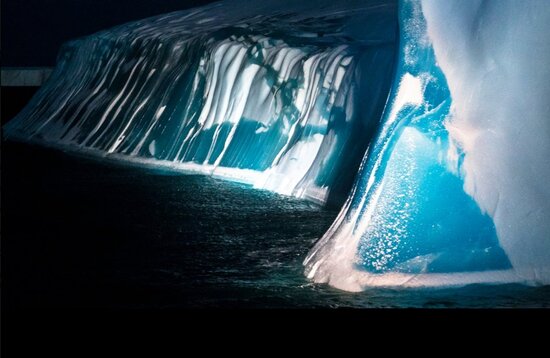A Copernicus study indicates that the effect of sea ice (fast ice connected to land) as a reinforcing force against land ice is negligible. The study area was the Larsen B ice shelf, which has been collapsing since 2002 and effectively disappeared after a major collapse in 2022.
We observe the evacuation of 11-year-old sea ice in Larsen Bay B on the East Antarctic Peninsula in January 2022, which was partly triggered by warm atmospheric conditions and strong offshore winds. This sea ice evacuation was closely followed by major changes in the calving behavior and dynamics of a subset of the ocean-terminating glaciers in the region. We show using satellite measurements that after a decade of gradual slowdown, the Hektoria, Green, and Crane glaciers accelerated by about 20–50% between February and the end of 2022, each increasing their speed by more than 100 but−1. In some circumstances, this is attributable to their transformation into tidewater glaciers after the loss of their ice shelves following the evacuation of coastal sea ice. However, a question remains as to whether coastal sea ice could have influenced the dynamics of these glaciers, or the stability of their ice shelves, through a buttressing effect similar to that of ice shelves confined on grounded ice streams. We show, using a series of diagnostic modeling experiments, that direct buttressing of coastal sea ice had a negligible impact on the dynamics of grounded ice streams. Furthermore, we suggest that the loss of coastal sea ice buttressing could have impacted the dynamics of rheologically weak ice shelves, thereby decreasing their stability over time; however, the resulting changes in the resistive stress distribution within the ice shelves would have been minor. This indicates that this loss of support by coastal sea ice is likely a secondary process in ice shelf disintegration compared to, for example, increased ocean swell or factors driving the initial disintegration of coastal sea ice.
The 2002 breakup.
In the summer of 2002, in the southern hemisphere, scientists monitoring satellite images of the Antarctic Peninsula daily watched in shock as nearly the entire Larsen B ice shelf broke apart and collapsed in just over a month. They had never seen such a vast area—3,250 square kilometers—disintegrate so quickly.
The breakup of 2022.
Scientists are still trying to figure out the reason for the breakup, but the start of the seasonal sea ice loss along the Antarctic Peninsula suggests that the southern summer was warm and wet. Rajashree Tri Datta, a scientist at the University of Colorado at Boulder, noted that foehn windsinfluenced by a large atmospheric river, contributed to destabilizing the ice shelf. The phenomenon is apparent in this animation composed from images from NOAA’s GEOS-16 satellite.
Artificial intelligence researchers at the University of Cambridge have mapped melting snow on the surface of Antarctic ice shelves for the first time. This is a new threat to the Antarctic continent. This time, the damage is on the ice sheet rather than the vast areas of decay beneath the massive ice shelves around Antarctica. Using NASA satellite imagery, it was determined that meltwater lakes and melting snow pose a threat because of their weight, and that surface meltwater has the potential to cause hydrofractures and collapses.
Melting snow, or wet snow, accounts for more than half of all Antarctic ice meltwater at the height of summer, but it is poorly accounted for in regional climate models.
Researchers led by the University of Cambridge used artificial intelligence techniques to map melting snow on Antarctic ice shelves and found that 57% of all meltwater is retained as melting snow, with the rest in surface ponds and lakes.
As the climate warms, more meltwater forms on the surface of ice shelves, the floating ice that surrounds Antarctica and acts as a buttress against the glaciers in the interior. Increased meltwater can cause ice shelves to become unstable or collapse, which in turn leads to rising sea levels.
The researchers also found that melting snow and accumulated meltwater cause 2.8 times more meltwater to form than standard climate models predict because it absorbs more heat from the sun than ice or snow. resultsreported in the journal Geosciences of naturecould have profound repercussions on the stability of the ice shelf and on the rise in sea level.
cut
“Because melting snow is more solid than meltwater, it won’t hydrofracture in the same way that lake water will, but it’s certainly something we need to consider when trying to predict how or if ice shelves will collapse,” Willis said.
In addition to the potential implications of melting snow for hydraulic fracturing, it also has a significant effect on melt rates. Because melting snow and lakes are less white than snow or ice, they absorb more heat from the sun, leading to more snowmelt. This additional melt is currently not accounted for in climate models, which can lead to underestimations of projections of ice sheet melt and ice shelf stability.
The study can be found in Nature Geoscience.
Bob Berwyn writes in Inside Climate News:
Earlier this week, a separate study In the same journal, studies also showed the increasing vulnerability of Antarctic ice shelves to melting from below, with the results suggesting that a warming ocean is likely to lead to “runaway melting”.

The damage caused by the Thwaites Glacier continues into the depths of winter. In the Amundsen Sea Bay, melting occurs all year round in the presence of open water.
To know more :
Damage to the ice tongue of the Astrolabe glacier (Adélie Coast, Antarctica).
Surface dynamics and calving cycle history of Astrolabe Glacier (Adélie Coast, Antarctica) from satellite images
By Denise Oliver Velez, Daily Kos blogger.
Caribbean Issues: The Devastating Aftermath of Hurricane Beryl